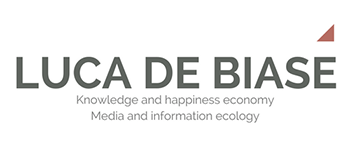Pierluca Santoro fa notare i dati che dimostrano come le conversazioni online si sviluppino spesso su piattaforme diverse da quelle dalle quali sono partiti i messaggi che le hanno generate.
E’ interessante perché dimostra che i vari blog, Twitter, Facebook, YouTube, Flickr ecc. non sono soltanto un aggregato di piattaforme in competizione ma, almeno dal punto di vista del pubblico attivo, sono un unico grande medium.
La metapiattaforma del pubblico attivo è il luogo astratto nel quale avvengono le conversazioni del pubblico attivo. I giornali ne sono coivolti per i loro singoli messaggi ma sono destinati a tentare di distinguersi. La mediasfera potrebbe essere il luogo nel quale si sviluppa la circolazione dell’informazione professionale e non professionale, nella quale vige l’infodiversità e tutti i generatori di senso si adoperano per connettersi pur coltivando la propria specificità identitaria e di servizio.






Ciao Luca,
una metapiattaforma che qualcuno da tempo identifica assai agevolmente nel Giant Global Graph .)
-> http://businesseconoscenza.blogspot.com/2008/03/una-rete-sempre-pi-sociale-da-mcluhan.html
-> http://dig.csail.mit.edu/breadcrumbs/node/215
Un modo di pensare a questa metapiattaforma assai più semplice, per certi versi.
In the long term vision, thinking in terms of the graph rather than the web is critical to us making best use of the mobile web, the zoo of wildy differing devices which will give us access to the system. Then, when I book a flight it is the flight that interests me. Not the flight page on the travel site, or the flight page on the airline site, but the URI (issued by the airlines) of the flight itself. That’s what I will bookmark. And whichever device I use to look up the bookmark, phone or office wall, it will access a situation-appropriate view of an integration of everything I know about that flight from different sources. The task of booking and taking the flight will involve many interactions. And all throughout them, that task and the flight will be primary things in my awareness, the websites involved will be secondary things, and the network and the devices tertiary.
I’ll be thinking in the graph. My flights. My friends. Things in my life. My breakfast. What was that? Oh, yogourt, granola, nuts, and fresh fruit, since you ask.
Aggregare la discontinuità insomma.
-> http://sioc-project.org/presentations
Ciao Luca,
una metapiattaforma che qualcuno da tempo identifica assai agevolmente nel Giant Global Graph .)
-> http://businesseconoscenza.blogspot.com/2008/03/una-rete-sempre-pi-sociale-da-mcluhan.html
-> http://dig.csail.mit.edu/breadcrumbs/node/215
Un modo di pensare a questa metapiattaforma assai più semplice, per certi versi.
In the long term vision, thinking in terms of the graph rather than the web is critical to us making best use of the mobile web, the zoo of wildy differing devices which will give us access to the system. Then, when I book a flight it is the flight that interests me. Not the flight page on the travel site, or the flight page on the airline site, but the URI (issued by the airlines) of the flight itself. That’s what I will bookmark. And whichever device I use to look up the bookmark, phone or office wall, it will access a situation-appropriate view of an integration of everything I know about that flight from different sources. The task of booking and taking the flight will involve many interactions. And all throughout them, that task and the flight will be primary things in my awareness, the websites involved will be secondary things, and the network and the devices tertiary.
I’ll be thinking in the graph. My flights. My friends. Things in my life. My breakfast. What was that? Oh, yogourt, granola, nuts, and fresh fruit, since you ask.
Aggregare la discontinuità insomma.
-> http://sioc-project.org/presentations
Mmmmmmm, Matteo sta cosa mi attizza.
Mediasfera, socialsfera, aggregazioni di ciò che per natura intrinseca nasce come disaggregato, disintermediato e, spessissimo, legato alle dinamiche indotte dalla piattaforma di origine.
Ontologia condivisa vo cercando? Pensi che dobbiamo descrivere dei metadati sule nostre elubacubrazioni per arrivare a un possibile aggregatore semantico?
@luca: Ops, avevo inserito il commento due volte per errore, mea culpa.
@gigicogo: l’aggregatore semantico ha un dilemma. Che deve funzionare fuori contesto, o meglio, deve gestire un metamodello di base, perchè potenzialmente dovrebbe gestire n contesti informativi diversi. Occorre ricondursi ad un minimo comune denominatore. Le 5W del giornalismo potrebbero essere interessanti come modello di base, a livello di presentazione.
A livello tecnico non ci sono problemi: la forma del metamodello RDF, la tripla di informazione simile all’analisi logica che abbiamo nel web strutturato, è quello che gestisce quello che ci serve sapere sulla struttura minima. Il resto esiste ( le ontologie base per molti dei domini di conoscenza tipici ci sono ), va solo renderizzato al meglio in merito al contesto.
Se poi le piattaforme abilitassero tali formati, saremmo a posto. Il problema è che questo non accade per il modello di business delle piattaforme stesse: che dovrebbero cambiarlo da inclusione unica dei dati aggregati a piattaforma di servizio per aggregare tali dati in forme più vicine agli utenti. E’ una domanda degli utenti, che pero’ ancora non emerge, purtroppo.
Un navigatore e quindi un aggregatore live per seguire il flusso potrebbe essere gFacet, uno dei più promettenti in effetti.
-> http://gfacet.semanticweb.org/
Quello che sta accadendo con gli Open Data sta accellerando probabilmente il processo di emersione della metapiattaforma, per il livello dei dati per ora, non tanto sulle interfacce d’uso.
che dovrebbero cambiarlo da inclusione unica dei dati aggregati a piattaforma di servizio per aggregare tali dati in forme più vicine agli utenti.